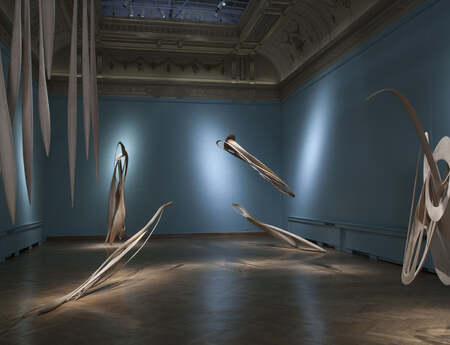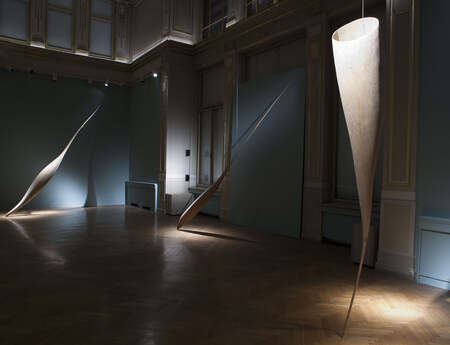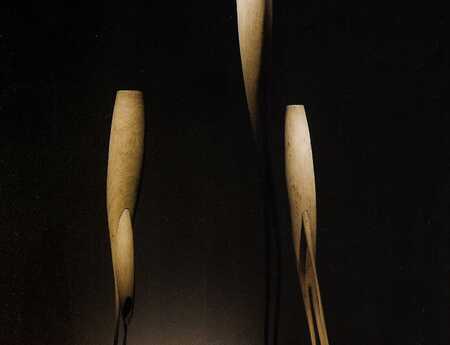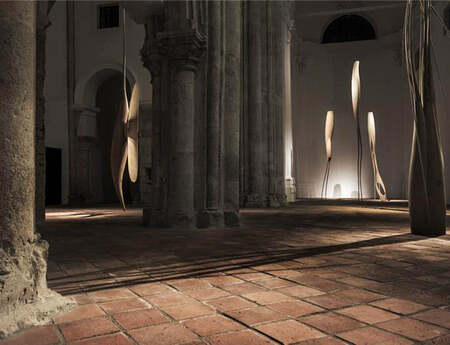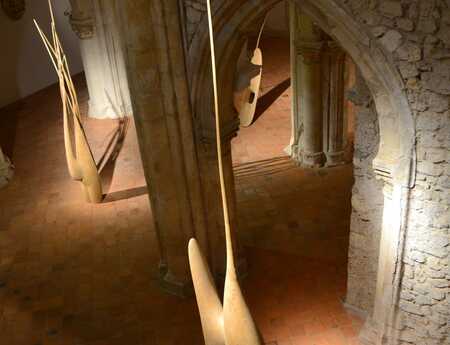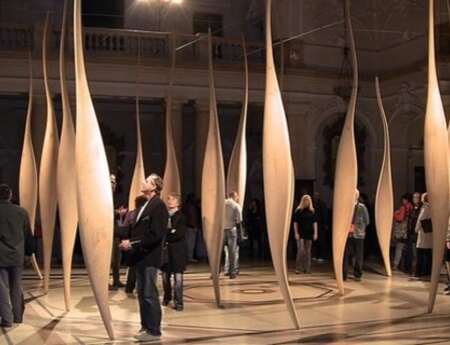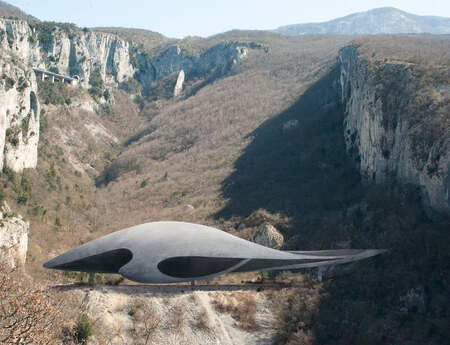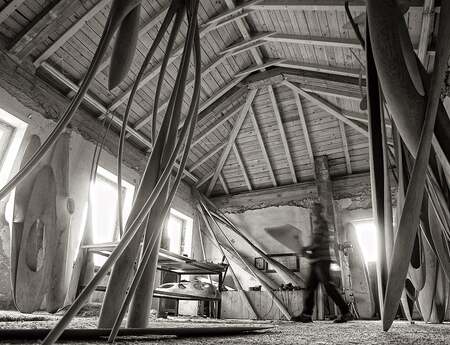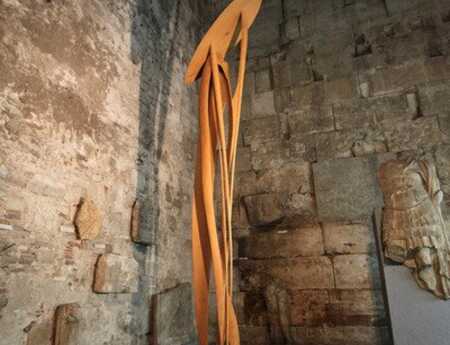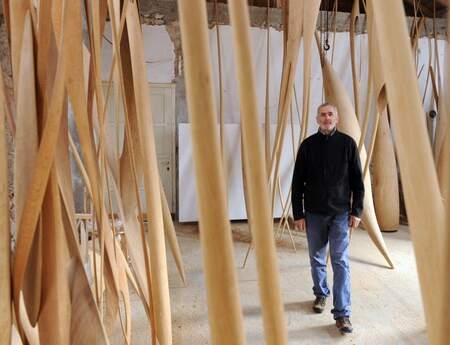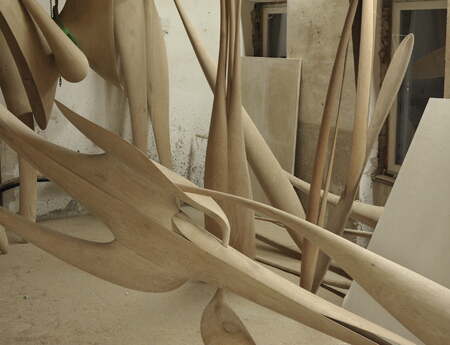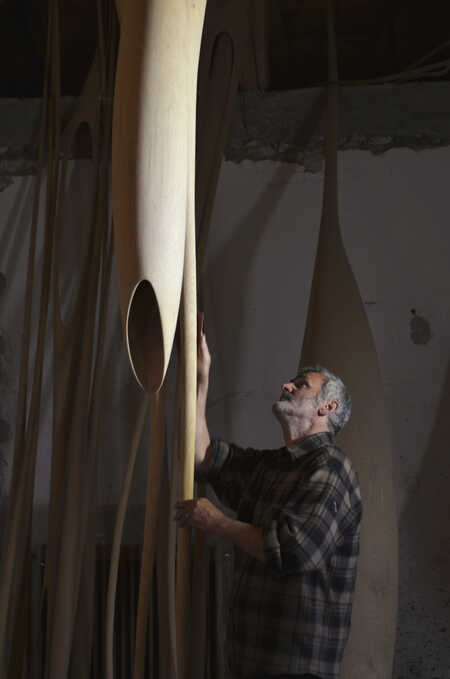
Essence of Nature
Mirko Zrinšćak (b. 1953, Volosko, Croatia) makes the invisible visible.
Living in seclusion on Mount Učka, a protected nature reserve in Croatia, his elongated pulsating, rhythmical forms are meditations on the underlying, invisible forces of nature, created in dialogue with the trees they are made from.
In the footsteps of modernist sculptors Constantin Brancusi, Jean Arp and Henry Moore, Zrinšćak searches for the essence of nature.
Zrinšćak is a master in working with wood. He developed his own technique to create hollow forms, enabling him to create floating shapes that travel through space. Mass is transformed in movement and space.
Just like the trees they are made of, these long, long shapes up to 7 meter move upwards. They reach for the sky as if they want to transcend their physical boundaries.
“We are nature. Some people think we humans are separate, but we are the same. We are energetically connected. We belong to the cosmos”.
Zrinšćak does not want to limit the meaning of his work. Everyone is free to make his own associations.
“These sculptures are felt, not seen. You use your stomach, not your head in looking at them”.
“These rhythmical flowing forms give a me a feeling of lightness, freedom, and transcendence. If you open your mind, you may feel the heartbeat of nature”, says Anne Berk, curator of the exhibition.
Forms of space
With endless patience, Mirko Zrinšćak created a small oeuvre of breathtakingly precise, fluid forms in wood, all made by himself. In Croatia, Zrinšćak is a celebrity, representing his home country at the Venice Biennial of 1995 and 2021, having solo shows in museums in Croatia, and winning a sculpture prize. Kunstcentret Silkeborg Bad is delighted to introduce his exceptional wooden sculptures to the Danish audience.
Instead of earthbound, massive forms resting heavily on the floor, as is usual for sculpture, Zrinšćak creates hollow, sensual forms and lines that are moving in space. In the main hall of the Kunstcentret, three elongated fragile forms rise up, and up, and up, their ultra-thin legs barely touching the ground, ready to take off and vibrate in space like the strings of a harp. Are they beings? Energy? There are no titles to give a clue.
Other shapes look more familiar, resembling the growth of trees, a bird in flight, the movement of a fish in the water, a drop of falling water, or a leaf reaching out for the light. Some shapes are more abstract, vibrating Forms of Space, as he called his 2008 exhibition in the Art Pavillion in Zagreb. Vibrating, dynamic shapes are combined into spatial constellations that lighten up in the dark, giving a cosmic feeling.
Essence of nature
During his daily walks in the forest, Zrinšćak makes photos of the grass bowing in the wind, snow softening the branches and especially of the endless, fluid movement of water. But he has no intention to copy nature. “These photos are like a diary, but I do not want to repeat the shapes of nature. It is only a starting point”.
In this respect, Zrinšćak follows in the footsteps of modernist sculptors like Henry Moore, Jean Arp and Constantin Brancusi, who famously stated: “When you see a fish you don't think of its scales. You think of its speed, its floating, flashing body seen through the water... I want just the flash of its spirit”.
Just like Brancusi Zrinšćak searches for the essence of nature, but he followed his own path, and developed his own form language. Zrinšćak finds his inspiration in contemplating the movement of the living nature around him, revealing the underlying energies that shape the universe.
Maker
Mirko Zrinšćak is a maker. He can make anything with his hands. He was born in 1953 in Volosko in former Yugoslavia, a small fishing village near the sea. As a young boy, he helped his father build the family house, which took 10 years to complete. As he didn’t like school, his parents sent him to Slovenia to study how to become a butcher. It opened his eyes for the anatomy that lies hidden behind the visible skin. “Bones are the building material of nature, sustaining the bodies of animals, plants or humans alike. They are optimized functional constructions, being able to resist pressure or not. I have studied the composition of flowers and the skeletons of birds, that must be very light”.
Becoming an artist
Before deciding to become an artist, Zrinšćak did many odd jobs, like working in a shipyard, being a waiter, or sailing around the world on big tankers. “It is very useful that you have life experience before you become an artist”. At 31, he enrolled in the Art Academy in Venice, studying painting with the renowned abstract expressionist painter Emilio Vedova. “The academy in Italy was more openminded then the one in Yugoslavia. Though in the eighties, we could make jokes about social realist art”. In 1985, after spending a year in KielKünstlerhaus, an artist in residency in Kiel. Then he returned to his country, settling in a small studio in Veprinac, at the foot of Mount Učka.
Mount Učka
For Mirko Zrinšćak art and life are one. He finds peace and inspiration in nature. In 1992, he moved to a logcabin in the middle of the forest, together with his wife, the painter Marina Banić-Zrinšćak. Five years later, after their first child was born, they moved to an abandoned school in Vela Učka, a hamlet located a thousand meters above sealevel. It has a studio of 1000 square meters.
"The house is located in Učka Nature Park, and on the western side the view extends all the way to the Dolomites. The beauty of the surrounding nature is very stimulating for my artistic work. During my long walks in the forest, I am sensitized to everything, even the smallest changes in nature. I perceive the small shifts that trigger me to think about art and life. That's how I came to perceive the world more in a holistic way. We are nature. Some people think we humans are separate, but we are the same. We are energetically connected. We belong to the cosmos”.
Tree
On Mount Učka he developed his own form language and his unique technique. Instead of painting, Zrinšćak started collecting natural and manmade objects bearing the marks of time. He combined them with handmade, sensitive wooden reliefs in altarlike presentations, as small cabinets of wonder, celebrating nature (We are Cosmic Series, 1988−1994).
“In 1992, I found a chestnut tree in the village that was decaying. It was great wood for carving! I was able to create a large reliefs. Afterwards, I took to oakwood to create very tall sculptures. There is a forest in East Croatia, that has perfect trees of 1 metre in diameter, and 30 meters tall. To create the elongated shapes I had in mind, I had to develop my own technique, but I liked that challenge”.
Physical labour
“I make these shapes in an era when no one has time anymore. It is very time consuming, but I don’t mind. On the contrary. My ideas evolve intuitively, in the process of making. Doing repetitive physical labour is like a meditation. I can fly in my mind”.
Hollow
Looking at the piles of tree trunks next to Zrinšćaks studio, you can hardly believe how he transformed these solid wooden logs into these vibrating, fluid and often hollow forms. First, he models the rough shapes in the log of the oak with a chainsaw. After dividing the form in two, he makes diagonal cuts, taking out all material, until a shell of only 1 centimeter is left. Then, after letting the two hemispheres dry for 1 or 2 (!) years in the shade, he glues them together, processing them by hand and patiently sanding them, until they obtain the perfect shape.
Reaching for Infinity
While carving, Zrinšćaks follows the shape of the tree. “In a way, you talk with the wood on an energy level. You charge the wood with your energy, like a battery. That is also sensed by the viewers”.
Zrinšćak makes use of the verticality of trees, growing upwards to the light, to create pulsating lines that seem to reach for infinity. Instead of standing on the floor, the hollow forms float in the air, as if escaping gravity. The undulating shapes are very light, dancing through space as materialized flows of energy.
Anne Berk NL, curator of the exhibition and vice-chairperson of the Sculpture Network
Mirko Zrinšćak, Essence of Nature, Kunstcentret Silkeborg Bad, Silkeborg,
5 October 2024 – 12 January 2025
